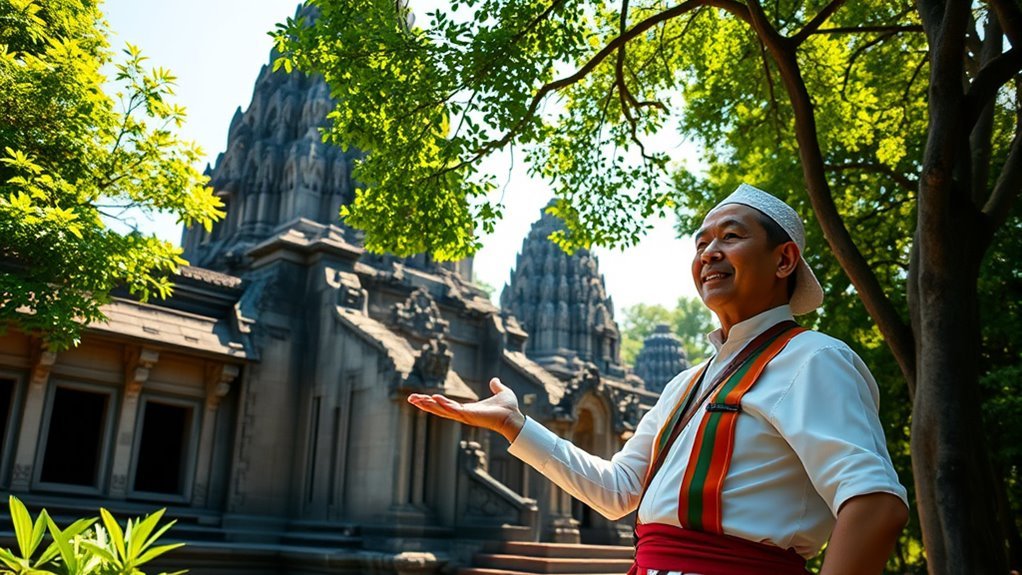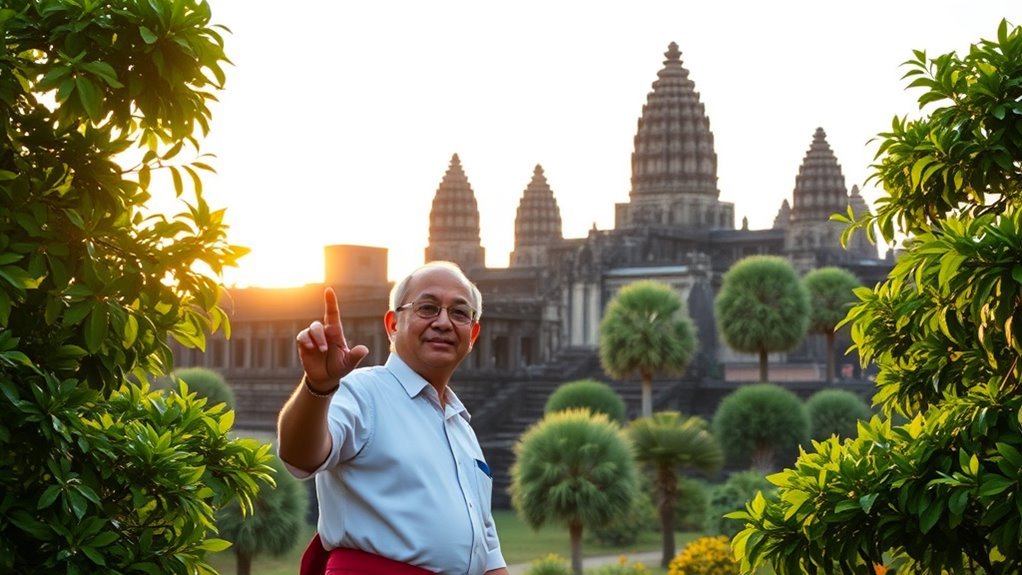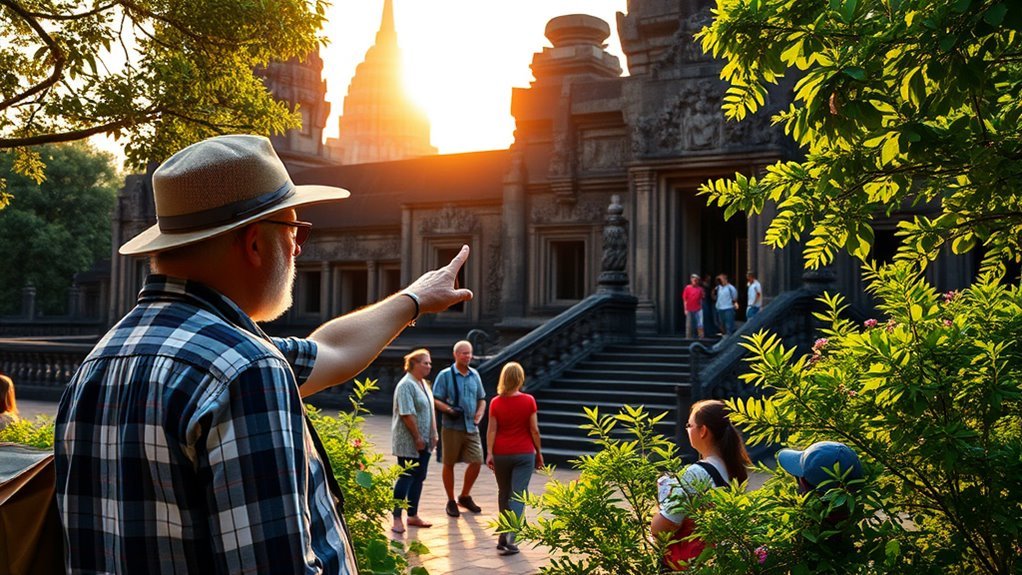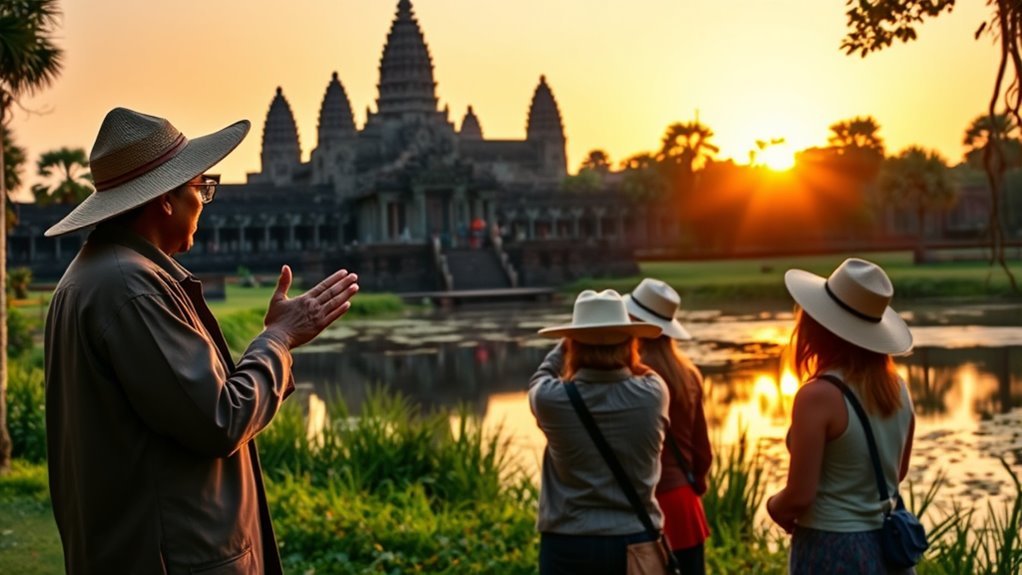Imagine stepping into the world of Angkor Wat, where history and spirituality merge within breathtaking architectural marvels. As you plan your visit, you’ll discover why this UNESCO World Heritage site is a must-see in Cambodia. With its rich blend of Hindu and Buddhist influences, there’s much to uncover. But how do you guarantee a fulfilling experience? There’s more to explore about the best ways to navigate this iconic destination.
Key Takeaways
- Angkor Wat is the largest religious monument globally, located in Siem Reap, Cambodia.
- The best visiting time is during the dry season, from November to May.
- Angkor Pass prices vary: $37 for one day, $62 for three days, $72 for seven days.
- Arrive early, around 4-5 AM, for a sunrise tour and fewer crowds.
- Hire a local guide for insights into the temple’s history and culture.
Overview of Angkor Wat

While exploring the marvels of Southeast Asia, you’ll find Angkor Wat in Siem Reap, Cambodia, standing as the largest religious monument in the world.
This impressive temple complex, a UNESCO World Heritage Site, covers over 162 hectares and was originally built by the Khmer Empire in the early 12th century. The site is famed for its stunning architecture and intricate carvings, including five iconic lotus-like towers symbolizing Mount Meru.
To experience this wonder, purchase an Angkor Pass, with options ranging from one to seven days.
The best time to visit is during the dry season, from November to May.
Don’t miss the breathtaking sunrise at Angkor Wat, a truly unforgettable spectacle that draws visitors from around the globe.
Historical Significance of Angkor
Although Angkor’s grandeur now captivates countless visitors, its historical significance lies in being the heart of the Khmer Empire, which thrived from the 9th to the 15th centuries.
Angkor Wat, an architectural marvel, initially served as a Hindu temple before evolving into a Buddhist site, reflecting its cultural importance. The urban layout, spanning over 1,000 square kilometers, was an indication of the empire’s sophistication and ambition.
Here are key aspects of Angkor’s historical significance:
- Cultural Importance: Angkor Wat symbolizes the intersection of Hindu and Buddhist traditions.
- Decline of Angkor: Factors like climate change and civil strife contributed to its fall.
- Restoration Efforts: Since 1907, ongoing efforts have preserved Angkor’s legacy, especially post-Cambodian Civil War.
The Khmer Empire’s legacy endures through Angkor’s ruins.
Exploring Angkor Temples

Have you ever wondered what it feels like to step back in time and wander through ancient wonders? Exploring Angkor is a journey through a tapestry of historical and cultural marvels.
Angkor Wat, the world’s largest religious monument, invites you to marvel at its five towering lotus-like spires. Angkor Thom’s Bayon Temple captivates with its 54 towers and over 200 stone faces.
Ta Prohm enchants with its iconic blend of nature and ruins, while Preah Khan offers a labyrinthine adventure amid intricate carvings and a serene lake.
With hundreds of temple complexes spread across the 400 square kilometers of Angkor Archaeological Park, multi-day tours are essential. Each site reveals distinct architectural styles, making every visit a unique experience.
Visiting Logistics and Costs
To visit Angkor Wat, you’ll need to purchase an Angkor Pass, available in three options: $37 for one day, $62 for three days, and $72 for seven days.
You can pay using various currencies, including US Dollars, Cambodian Riel, Thai Baht, or Euros, but remember to buy your pass in person at the ticket office.
Make sure to dress respectfully, with shoulders and knees covered, as it’s required for temple visits.
Angkor Pass Options
When planning your visit to the Angkor Archaeological Park, securing an Angkor Pass is essential. You can choose from several options:
- One-day pass: Costs $37 and is perfect if you’re short on time.
- Three-day pass: At $62, it’s valid for 10 days, allowing multiple visits.
- Seven-day pass: Priced at $72, it’s valid for one month for extended explorations.
Buy your pass at the ticket office, which opens at 5 am for sunrise visits. They accept US Dollars, Cambodian Riel, Thai Baht, or Euros.
Payment Method Details
Purchasing your Angkor Pass is an essential step in visiting the Angkor Archaeological Park, and understanding the payment methods will make the process smoother. You can acquire your pass at the ticket office, where a photograph is needed. Payment is accepted in multiple currencies, including US Dollars and Cambodian Riel. To avoid long queues, consider an online purchase, which allows you to carry an e-ticket on your phone. Various checkpoints will verify ticket validity, so keep your e-ticket handy.
| Pass Type | Price (USD) |
|---|---|
| One-day | $37 |
| Three-day | $62 |
| Seven-day | $72 |
Dress Code Recommendations
Have you considered what to wear when visiting Angkor Wat? Following the dress code is essential to show respect and gain access to this sacred site. Make sure your shoulders and knees are covered to adhere to the respectful attire guidelines.
Here are some tips to navigate the cultural sensitivities at Angkor Wat:
- Lightweight Clothing: Opt for breathable fabrics to stay comfortable in the hot climate. Avoid shorts and tank tops to respect the religious significance of the site.
- Comfortable Shoes: You’ll be walking extensively around the temple complex, so wear sturdy, comfortable shoes.
- Light Scarf: Carry a light scarf or shawl to cover shoulders and arms, especially for women, as a precaution against cultural sensitivities.
Dress appropriately and enjoy your visit!
Tips for an Enhanced Experience
Ever wondered how to make your visit to Angkor Wat truly unforgettable? This Angkor Wat guide provides essential travel tips for an enhanced experience.
Arrive early, around 4-5 AM, to catch the stunning sunrise at Angkor and avoid the crowds that gather later. Hiring a local guide can offer valuable insights into the history and culture of the temples, enriching your visit to Angkor Wat.
With the hot climate, it’s vital to stay hydrated, so carry water as you explore Angkor Wat. Dress respectfully, covering shoulders and knees, as temple entrances enforce dress codes to maintain sanctity.
Protect yourself from the sun with sunscreen, hats, and sunglasses, especially during midday heat while walking extensively between temples.
Respecting the Site and Exploring Beyond

While visiting Angkor Wat, it’s important to respect both the cultural and historical significance of this UNESCO World Heritage Site. Dress appropriately by covering your shoulders and knees, preserving the temple complex’s dignity.
Don’t touch the carvings or climb the ancient structures, as these actions can damage the archaeological site.
Beyond Angkor Wat, explore beyond to discover other gems like Angkor Thom, Bayon Temple, and Ta Prohm, each offering diverse architectural styles and historical significance.
Enhance your visit by engaging with the local culture respectfully:
- Photographing: Always ask permission before capturing images of monks or locals.
- Souvenirs: Don’t take relics or stone shards from the site.
- Wildlife: Beware of monkeys; they might steal food or bite.
Respect guarantees an enriching experience while visiting Angkor Wat.
Best Time to Visit Angkor Wat
Although Angkor Wat is a year-round destination, timing your visit can greatly enhance your experience.
The best time to visit Angkor is during the dry season, from November to May. You’ll enjoy cooler temperatures and pleasant conditions perfect for exploring. November stands out in this travel guide as it offers mild weather and fewer tourists, avoiding the peak crowds of December to February.
If you visit during the wet season (May to October), you’ll find fewer crowds and a vibrant, lush landscape, but expect daily rain showers.
To capture the breathtaking sunrise, arrive early around 4-5 AM. This timing helps you avoid the heat and crowds, providing a serene view of Angkor Wat’s majestic silhouette.
Accommodation Options in Siem Reap

Siem Reap is home to a diverse array of accommodation options, catering to every type of traveler.
Whether you’re seeking luxury hotels, boutique hotels, or budget-friendly stays, you’ll find what you need.
Here’s a quick guide:
- Luxury Hotels: Consider Anantara Angkor Resort for romantic Khmer villa-style suites.
It offers private balconies, spas, and personalized services, making it ideal for a lavish stay.
- Boutique Hotels: Shinta Mani Shack is a chic option with sustainable practices.
Enjoy unique designs and serene surroundings that feel exclusive yet welcoming.
- Budget Travelers: Onederz Hostel provides a social atmosphere with amenities like an outdoor saltwater pool.
It’s perfect if you want affordability without sacrificing comfort.
Siem Reap’s accommodations guarantee a memorable visit, blending comfort with culture.
Planning Your Visit to Angkor Wat
When planning your visit to Angkor Wat, start by purchasing an Angkor Pass, available for one, three, or seven days, online or at the site.
Aim to visit during the dry season from November to May, and arrive early to catch the breathtaking sunrise and beat the crowds.
For convenient temple hopping, hire a tuk-tuk for about $20 a day, ensuring you can easily navigate the vast archaeological park.
Angkor Pass Options
Visiting Angkor Wat is an unforgettable experience, and obtaining the right Angkor Pass is your first step. You’ll need this pass to explore the Angkor Archaeological Park. Here’s what you should know:
- Ticket Options: Choose a 1-day pass for $37, a 3-day pass for $62, or a 7-day pass for $72. The 3-day pass offers flexibility with 10-day validity.
- Ticket Purchase: Buy your pass in person at the ticket office. Arrive early—doors open at 5 am—so you can catch the sunrise. Payment is accepted in US Dollars and other currencies.
- Ticket Validity: Checkpoints enforce ticket validity. Carry an e-ticket on your phone to guarantee seamless access as you explore.
Ideal Travel Schedule
With your Angkor Pass secured, it’s time to plan the perfect itinerary for your Angkor Wat adventure.
Begin your day with an unforgettable sunrise tour at Angkor Wat around 4:30 am to witness the breathtaking dawn. Afterward, visit the surrounding temples like Ta Prohm, Neak Pean, and Tak Keo.
An ideal itinerary spans at least three days, giving you ample time to explore Angkor’s intricate architecture and rich history. To navigate between sites, consider hiring a tuk-tuk, costing about $20 per day, offering flexibility and convenience.
Choose from entry options with ticket prices of $37 for a day or $62 for three days. Arriving early helps you avoid crowds and ensures you make the most of your experience within the temples’ operating hours.
Transport and Access
If you’re planning a visit to Angkor Wat, understanding your transport and access options is essential for a smooth experience. From Siem Reap, you can choose from several transportation options, such as tuk-tuks, bicycles, or car hire. Tuk-tuks are popular and cost around $20 for a full day.
Secure your Angkor Pass at the ticket office, which opens at 5 AM, to avoid long queues and catch the stunning sunrise. A one-day pass is $37, offering access to the main temples.
To optimize your visit:
- Arrive early: Beat the crowds and begin exploring as the main temples open.
- Choose your season: Visit in the dry season for favorable conditions.
- Plan your time: Allocate sufficient time to explore the complex.
Conclusion
To fully appreciate Angkor Wat’s grandeur, plan your visit carefully. Arrive early to witness a stunning sunrise, and hire a local guide for deeper insights into its rich history. Explore the intricate temples at your own pace, respecting the site’s cultural significance. Choose the right ticket option for your needs, and visit during the dry season for the best experience. With thoughtful planning, your journey to Angkor Wat will be both memorable and enriching.
FAQs
1. How Much Does a Guide Cost at Angkor Wat?
You’ll find guides at Angkor Wat charging $25 to $50 for half-day tours and $50 to $100 for full-day experiences. Check group rates or book ahead for discounts. Always negotiate and confirm what’s included upfront.
2. How Many Days Are Needed to See Angkor Wat?
You should plan for at least three days to explore Angkor Wat thoroughly. This gives you time to enjoy the main temples, take breaks, and soak in the history without rushing. Consider a seven-day pass for deeper exploration.
3. Is It Okay to Wear Shorts in Angkor Wat?
You can wear shorts at Angkor Wat, but make sure they’re knee-length. Bring a lightweight shawl to cover your shoulders and knees when needed. Respect the dress code to avoid being denied entry to certain areas.
4. What’s the Best Way to Do Angkor Wat?
To make the most of your experience, start early for the sunrise, buy a 3-day pass, and hire a tuk-tuk. Visit Ta Prohm first, dress respectfully, and carry essentials like water and sunscreen for a comfortable experience.

